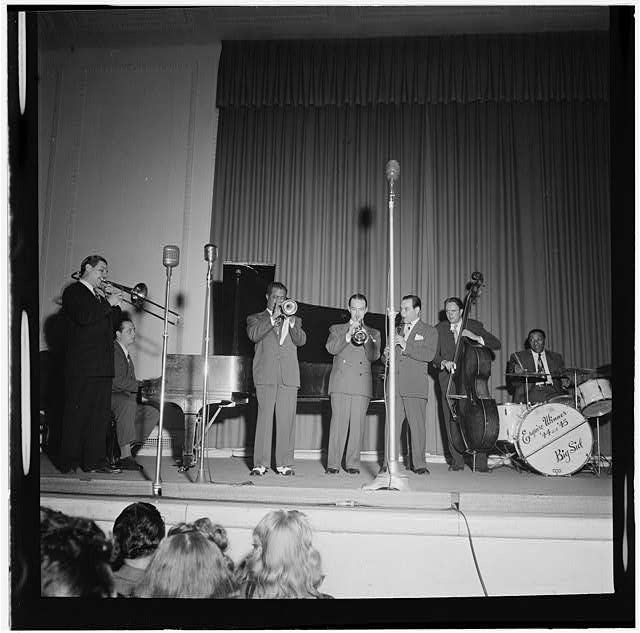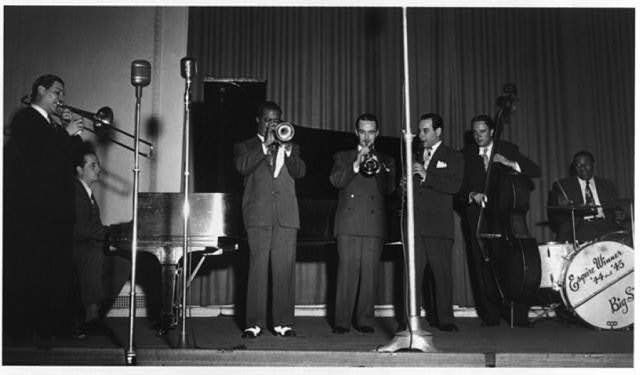 On May 17, 1947, Louis Armstrong gave an all-star concert at New York’s Town Hall that changed his life. He had been leading a touring big band since 1929, but World War II brought the Swing Era to an end, and by 1947 Armstrong knew that he had to find a different way to package himself for postwar audiences. He did so at the Town Hall concert, which teamed him with a small group whose members included Sid Catlett, Bobby Hackett, and Jack Teagarden. As I wrote in A Cluster of Sunlight: The Life of Louis Armstrong:
On May 17, 1947, Louis Armstrong gave an all-star concert at New York’s Town Hall that changed his life. He had been leading a touring big band since 1929, but World War II brought the Swing Era to an end, and by 1947 Armstrong knew that he had to find a different way to package himself for postwar audiences. He did so at the Town Hall concert, which teamed him with a small group whose members included Sid Catlett, Bobby Hackett, and Jack Teagarden. As I wrote in A Cluster of Sunlight: The Life of Louis Armstrong:
It was, for one thing, the first time that he had ever given a full-evening concert with a combo, and it appears to have been the first time since 1926 that he had appeared in public as the leader of a small group of his own. Not that he needed a good band to play well. “I work with two bands, the one on stage and the one in my head,” he would later tell Ruby Braff. “If they sound good on stage, O.K., I’ll play with them. If not, I just turn up the volume of the band in my head.” But the band with which he was playing at Town Hall that night sounded very good indeed…
At the time, comparatively little fuss was made over the event, which went unmentioned in the New York Times, Time, and The New Yorker. Only the jazz press took note of the occasion: Down Beat‘s review was headed “Satchmo’s Genius Still Lives,” while The Melody Maker ran a piece by a correspondent who reported that Armstrong’s playing “had all the freshness and vigour of the early Hot Five and Seven days. He never strove for effects, never played to the gallery.” But one person in the audience was listening with the closest possible attention. Joe Glaser, Armstrong’s manager, who was sitting in a box seat, knew at once that his troubles were over. Not only had Armstrong proved himself capable of thrilling a crowd without the support of a big band, but in Jack Teagarden he had found the foil of a lifetime. Like the businessman he was, Glaser struck while the iron was smoking hot. He signed Teagarden to a long-term contract on Monday morning, then gave the members of the big band two months’ notice.
Three months after that, Armstrong opened at Billy Berg’s, a Los Angeles nightclub, leading a six-piece combo whose other members included Sid Catlett and Jack Teagarden. The engagement was a huge success, and for the rest of his life Armstrong toured the world with the band that Glaser later dubbed “the All Stars.”
 Rarely have microphones been present at so historically significant a one-night stand as Armstrong’s 1947 Town Hall concert, but Ernie Anderson, the promoter who persuaded Glaser to let him present the concert, took care to record it, and the resulting album leaves no possible doubt that it was as good as everybody remembered. Fortunately, the great jazz photographer Bill Gottlieb was also present, and took a beautiful group shot of Armstrong and his musicians in full cry. A cropped version of the photo was published two months later in Down Beat, but the original vanished into Gottlieb’s files, and it didn’t resurface until he left his personal archive of sixteen hundred prints and negatives to the Library of Congress, which has created an online collection of Gottlieb’s work.
Rarely have microphones been present at so historically significant a one-night stand as Armstrong’s 1947 Town Hall concert, but Ernie Anderson, the promoter who persuaded Glaser to let him present the concert, took care to record it, and the resulting album leaves no possible doubt that it was as good as everybody remembered. Fortunately, the great jazz photographer Bill Gottlieb was also present, and took a beautiful group shot of Armstrong and his musicians in full cry. A cropped version of the photo was published two months later in Down Beat, but the original vanished into Gottlieb’s files, and it didn’t resurface until he left his personal archive of sixteen hundred prints and negatives to the Library of Congress, which has created an online collection of Gottlieb’s work.
I was lucky enough to be casually acquainted with Gottlieb, who died a couple of years ago, and I knew as soon as I started choosing the illustrations for A Cluster of Sunlight that his Town Hall photograph would have to be included. I’m pleased to say that his son Edward has given me permission to reprint this essential document of the most consequential performance of Louis Armstrong’s life. It isn’t as well known as it ought to be, perhaps because it isn’t all that dramatic, but even so, no Armstrong biography could possibly be complete without it.
